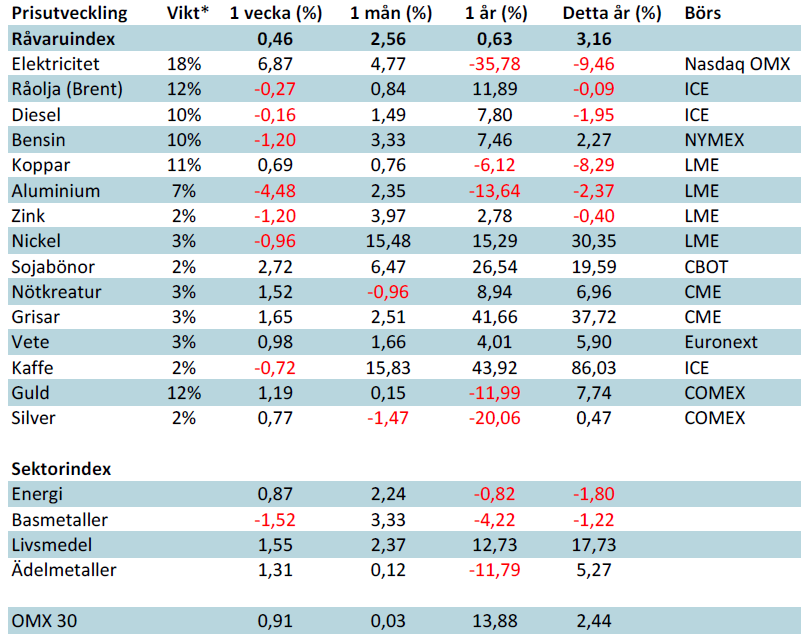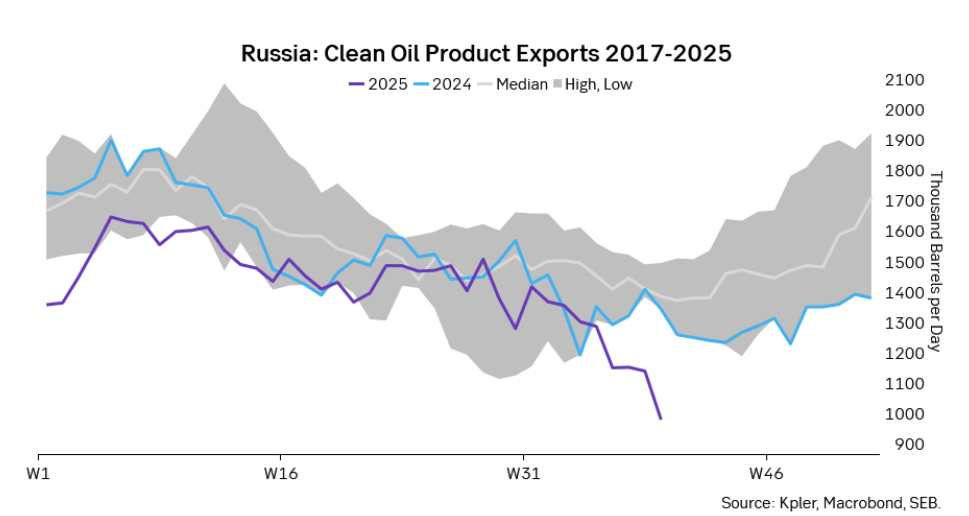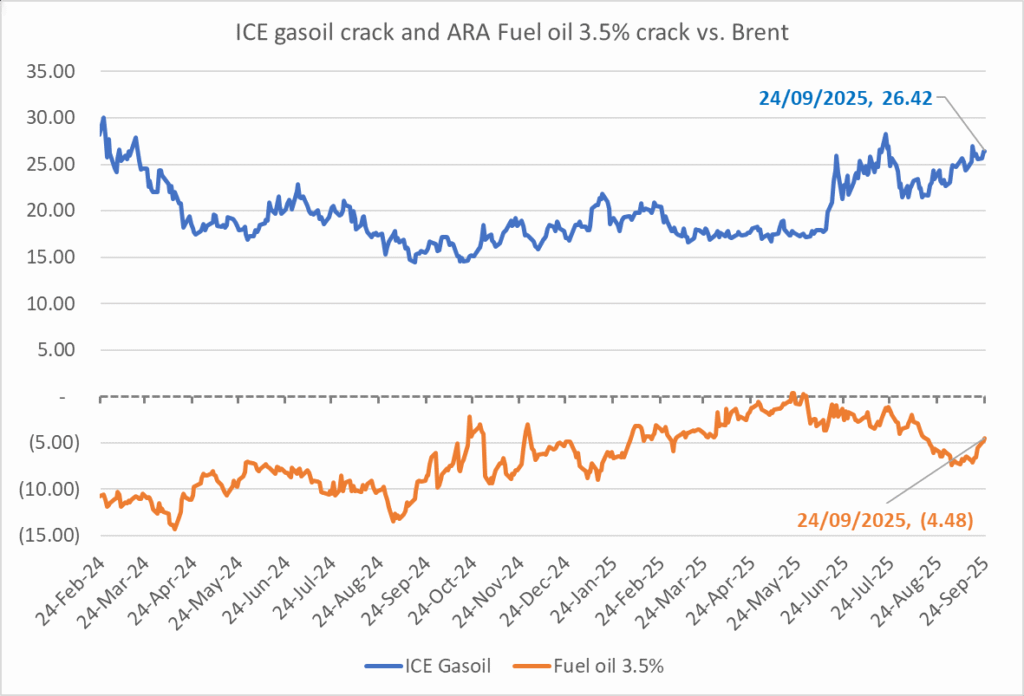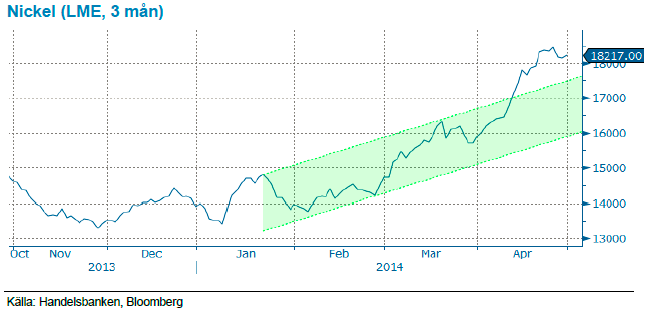Analys
SHB Råvarubrevet 30 april 2014

Råvaror allmänt: Kina tynger, Europa ser ljuset
 Kinesisk data var en rejäl “bang” under första kvartalet. Sämre än väntat på alla håll och kanter. Överraskningsindex har fallit till lägsta nivåerna sedan Lehman-krisen. Ekonomers förväntningar har nu justerats ner och framöver borde data inte vara negativ överraskning även om aktiviteten inte ser ut att förbättras nämnvärt. I Europa fortsätter däremot data att beskriva en ljusare framtid. Låga räntekostnader efter Draghi´s ”whatever it takes” kommentar i juli 2012 sipprar igenom systemet till ökad slutkonsumtion. Vinterns negativa överraskningar i USA, härledda till det smällkalla vädret har dragit förbi. Vi fortsätter dock att tro att 2013 års nedskalning av QE kommer tynga ekonomin.
Kinesisk data var en rejäl “bang” under första kvartalet. Sämre än väntat på alla håll och kanter. Överraskningsindex har fallit till lägsta nivåerna sedan Lehman-krisen. Ekonomers förväntningar har nu justerats ner och framöver borde data inte vara negativ överraskning även om aktiviteten inte ser ut att förbättras nämnvärt. I Europa fortsätter däremot data att beskriva en ljusare framtid. Låga räntekostnader efter Draghi´s ”whatever it takes” kommentar i juli 2012 sipprar igenom systemet till ökad slutkonsumtion. Vinterns negativa överraskningar i USA, härledda till det smällkalla vädret har dragit förbi. Vi fortsätter dock att tro att 2013 års nedskalning av QE kommer tynga ekonomin.
Basmetaller: Byter till neutral vy på nickel
Vi har länge haft nickel som vår favoritmetall då den handlats på låga nivåer där 40 % av gruvorna gick back. Den 1:a april skickade vi ut ett tradingcase där vi intensifierade vår starka tro på stigande nickelpris efter att Indonesiens exportförbud på nickelmalm från den 12e januari såg ut att vara robust samtidigt som den eskalerande krisen mellan Ryssland och Ukraina fick finansmarknaden att handla upp nickel på oror för att Ryssland skulle införa exportrestriktioner på nickel som en kontramanöver på eventuella handelssanktioner från Väst.
Sedan den 1a april har vårt certifikat Long Nickel H stigit 15 % och Bull nickel med 29 %. I vårt case hade vi en tro att nickel skulle stiga stadigt under året i takt med att Kina betar av sina lager av den malm som man nu inte längre kan importera från Indonesien. I och med situationen kring Ryssland har hela prisrörelsen kommit på kort tid och därför kliver vi av tåget och är nöjda med vinsten. Vi tror inte att priset har så stor nedsida härifrån men risk/award på de här nivåerna är i dagsläget inte lockande i våra ögon.
Ädelmetaller: Ikväll är det dags!
Ikväll är det dags för Federal Reserves tredje räntemöte för året, och därmed det vi ansett vara de viktigaste för guldprisutvecklingen framöver. Fed har gått från att bedömas vara hökaktiga till nu mer mjuka i sin syn på räntepolitiken och det har skapat en hel del rörelser på räntemarknaden. Guldet har dock spenderat hela april månad i en väldigt tight range, och vi stänger månaden på exakt samma nivå som vi öppnade den, på 1290 USD per uns.
Det gör att vi anser att Fed ikväll måste säga något eller göra något som överraskar marknaden ganska rejält för att det ska orsaka stora prisrörelser på kort sikt. Det ser dock ut som att kvällens besked knappast blir någon kioskvältare, av alla ekonomer som prognosticerar QE tror samtliga på en takt om 45 miljarder USD per månad, en minskning om 10 miljarder, vilket närmast garanterat blir det besked som lämnas. Marknadsreaktionerna kommer istället att skapas av det finstilta i pressmeddelandet, och vi återkommer med en kort sammanfattning av reaktioner och vyer på fredag. Vi bibehåller vår positiva syn på guldet fortsatt, men uppdaterar den om ny information framkommer i kvällens besked.
Energi: Ukraina och Libyen ger stöd till oljepriset
Oljan handlas fortsatt på höga nivåer efter att tonläget mellan USA och Ryssland höjts där Nato manade till rysk truppreträtt samtidigt som Libyska parlamentet stormades av beväpnade män och tvingat parlamentets ledamöter att avbryta en omröstning om premiärministerposten. Libyen är utöver utvecklingen kring Ukraina en avgörande faktor för utvecklingen på kort sikt. Igår lyfte rebeller blockaden vid Zweitinahamnen, en av de fyra terminaler som regeringen förlorade kontrollen vid i juli förra året och en av de två som enligt överenskommelsen från 6 april skulle återupptas. Denna blockad beräknas ha kostat Libyen uppemot 8 miljarder dollar om vi ser till produktionsbortfallet om närmare 1.15 miljoner fat per dag (från 1.4 miljoner till 250,000 fat i mars 2014). Libyen som sitter på en stor reserv kan inte annat än betraktas som ett osäkert kort och motiverar fortsatt en riskpremie tills dess att regeringen återfår kontrollen över landets oljeproduktion. En faktor som talar för ett fallande oljepris är amerikanska lagersiffror som förväntas stiga med ytterligare 1.9 miljoner fat i dagens rapport vilket i kombination med dagens penningpolitiska besked från Fed ligger närmast till hands att snegla på.
Livsmedel: Kaffepriset på nya höjder
Terminspriserna på Arabicakaffe steg i förra veckan till nya höjder igen och nådde årshögsta efter att den ansedda schweiziska kaffehandlaren, Volcafe justerade ned sitt estimat för årets skörd i Brasilien till 18 procent lägre än föregående period. Världens största kaffeproducent som lyckats redovisa flera år av rekordskördar, riskerar även ett produktionsbortfall uppemot 20 procent för nästkommande år. Skörden är påbörjad i delar av landet och kaffehandlare runt om i världen är nu eniga om att årets första två månader med uteblivet regn inte kommer kunna kompenseras av den nederbörd landet fick under mars månad. Sent i fredags eftermiddag föll priserna igen under 2 dollar/Ib efter nya vinsthemtagningar för att stiga tillbaka igen under gårdagen. Vi tror fortsatt på en instabil marknad i några månader till – skörden är endast i initialfasen, där nya estimat och väderrapporter kan driva kaffepriserna till nya höjder.
Handelsbankens råvaruindex (USD)

*Uppdaterade vikter från 29 november 2013
Handelsbankens råvaruindex består av de underliggande indexen för respektive råvara. Vikterna är bestämda till hälften från värdet av nordisk produktion (globala produktionen för sektorindex) och till hälften från likviditeten i terminskontrakten.
[box]SHB Råvarubrevet är producerat av Handelsbanken och publiceras i samarbete och med tillstånd på Råvarumarknaden.se[/box]
Ansvarsbegränsning
Detta material är producerat av Svenska Handelsbanken AB (publ) i fortsättningen kallad Handelsbanken. De som arbetar med innehållet är inte analytiker och materialet är inte oberoende investeringsanalys. Innehållet är uteslutande avsett för kunder i Sverige. Syftet är att ge en allmän information till Handelsbankens kunder och utgör inte ett personligt investeringsråd eller en personlig rekommendation. Informationen ska inte ensamt utgöra underlag för investeringsbeslut. Kunder bör inhämta råd från sina rådgivare och basera sina investeringsbeslut utifrån egen erfarenhet.
Informationen i materialet kan ändras och också avvika från de åsikter som uttrycks i oberoende investeringsanalyser från Handelsbanken. Informationen grundar sig på allmänt tillgänglig information och är hämtad från källor som bedöms som tillförlitliga, men riktigheten kan inte garanteras och informationen kan vara ofullständig eller nedkortad. Ingen del av förslaget får reproduceras eller distribueras till någon annan person utan att Handelsbanken dessförinnan lämnat sitt skriftliga medgivande. Handelsbanken ansvarar inte för att materialet används på ett sätt som strider mot förbudet mot vidarebefordran eller offentliggörs i strid med bankens regler.
Analys
OPEC+ will likely unwind 500 kb/d of voluntary quotas in October. But a full unwind of 1.5 mb/d in one go could be in the cards

Down to mid-60ies as Iraq lifts production while Saudi may be tired of voluntary cut frugality. The Brent December contract dropped 1.6% yesterday to USD 66.03/b. This morning it is down another 0.3% to USD 65.8/b. The drop in the price came on the back of the combined news that Iraq has resumed 190 kb/d of production in Kurdistan with exports through Turkey while OPEC+ delegates send signals that the group will unwind the remaining 1.65 mb/d (less the 137 kb/d in October) of voluntary cuts at a pace of 500 kb/d per month pace.

Signals of accelerated unwind and Iraqi increase may be connected. Russia, Kazakhstan and Iraq were main offenders versus the voluntary quotas they had agreed to follow. Russia had a production ’debt’ (cumulative overproduction versus quota) of close to 90 mb in March this year while Kazakhstan had a ’debt’ of about 60 mb and the same for Iraq. This apparently made Saudi Arabia angry this spring. Why should Saudi Arabia hold back if the other voluntary cutters were just freeriding? Thus the sudden rapid unwinding of voluntary cuts. That is at least one angle of explanations for the accelerated unwinding.
If the offenders with production debts then refrained from lifting production as the voluntary cuts were rapidly unwinded, then they could ’pay back’ their ’debts’ as they would under-produce versus the new and steadily higher quotas.
Forget about Kazakhstan. Its production was just too far above the quotas with no hope that the country would hold back production due to cross-ownership of oil assets by international oil companies. But Russia and Iraq should be able to do it.
Iraqi cumulative overproduction versus quotas could reach 85-90 mb in October. Iraq has however steadily continued to overproduce by 3-5 mb per month. In July its new and gradually higher quota came close to equal with a cumulative overproduction of only 0.6 mb that month. In August again however its production had an overshoot of 100 kb/d or 3.1 mb for the month. Its cumulative production debt had then risen to close to 80 mb. We don’t know for September yet. But looking at October we now know that its production will likely average close to 4.5 mb/d due to the revival of 190 kb/d of production in Kurdistan. Its quota however will only be 4.24 mb/d. Its overproduction in October will thus likely be around 250 kb/d above its quota with its production debt rising another 7-8 mb to a total of close to 90 mb.
Again, why should Saudi Arabia be frugal while Iraq is freeriding. Better to get rid of the voluntary quotas as quickly as possible and then start all over with clean sheets.
Unwinding the remaining 1.513 mb/d in one go in October? If OPEC+ unwinds the remaining 1.513 mb/d of voluntary cuts in one big go in October, then Iraq’s quota will be around 4.4 mb/d for October versus its likely production of close to 4.5 mb/d for the coming month..
OPEC+ should thus unwind the remaining 1.513 mb/d (1.65 – 0.137 mb/d) in one go for October in order for the quota of Iraq to be able to keep track with Iraq’s actual production increase.
October 5 will show how it plays out. But a quota unwind of at least 500 kb/d for Oct seems likely. An overall increase of at least 500 kb/d in the voluntary quota for October looks likely. But it could be the whole 1.513 mb/d in one go. If the increase in the quota is ’only’ 500 kb/d then Iraqi cumulative production will still rise by 5.7 mb to a total of 85 mb in October.
Iraqi production debt versus quotas will likely rise by 5.7 mb in October if OPEC+ only lifts the overall quota by 500 kb/d in October. Here assuming historical production debt did not rise in September. That Iraq lifts its production by 190 kb/d in October to 4.47 mb/d (August level + 190 kb/d) and that OPEC+ unwinds 500 kb/d of the remining quotas in October when they decide on this on 5 October.

Analys
Modest draws, flat demand, and diesel back in focus

U.S. commercial crude inventories posted a marginal draw last week, falling by 0.6 million barrels to 414.8 million barrels. Inventories remain 4% below the five-year seasonal average, but the draw is far smaller than last week’s massive 9.3-million-barrel decline. Higher crude imports (+803,000 bl d WoW) and steady refinery runs (93% utilization) helped keep the crude balance relatively neutral.

Yet another drawdown indicates commercial crude inventories continue to trend below the 2015–2022 seasonal norm (~440 million barrels), though at 414.8 million barrels, levels are now almost exactly in line with both the 2023 and 2024 trajectory, suggesting stable YoY conditions (see page 3 attached).
Gasoline inventories dropped by 1.1 million barrels and are now 2% below the five-year average. The decline was broad-based, with both finished gasoline and blending components falling, indicating lower output and resilient end-user demand as we enter the shoulder season post-summer (see page 6 attached).
On the diesel side, distillate inventories declined by 1.7 million barrels, snapping a two-week streak of strong builds. At 125 million barrels, diesel inventories are once again 8% below the five-year average and trending near the low end of the historical range.
In total, commercial petroleum inventories (excl. SPR) slipped by 0.5 million barrels on the week to ish 1,281.5 million barrels. While essentially flat, this ends a two-week streak of meaningful builds, reflecting a return to a slightly tighter situation.
On the demand side, the DOE’s ‘products supplied’ metric (see page 6 attached), a proxy for implied consumption, softened slightly. Total demand for crude oil over the past four weeks averaged 20.5 million barrels per day, up just 0.9% YoY.
Summing up: This week’s report shows a re-tightening in diesel supply and modest draws across the board, while demand growth is beginning to flatten. Inventories remain structurally low, but the tone is less bullish than in recent weeks.


Analys
Are Ukraine’s attacks on Russian energy infrastructure working?

Brent crude rose 1.6% yesterday. After trading in a range of USD 66.1 – 68.09/b it settled at USD 67.63/b. A level which we are well accustomed to see Brent crude flipping around since late August. This morning it is trading 0.5% higher at USD 68/b. The market was expecting an increase of 230 kb/d in Iraqi crude exports from Kurdistan through Turkey to the Cheyhan port but that has so far failed to materialize. This probably helped to drive Brent crude higher yesterday. Indications last evening that US crude oil inventories likely fell 3.8 mb last week (indicative numbers by API) probably also added some strength to Brent crude late in the session. The market continues to await the much heralded global surplus materializing as rising crude and product inventories in OECD countries in general and the US specifically.

The oil market is starting to focus increasingly on the successful Ukrainian attacks on Russian oil infrastructure. Especially the attacks on Russian refineries. Refineries are highly complex and much harder to repair than simple crude oil facilities like export pipelines, ports and hubs. It can take months and months to repair complex refineries. It is thus mainly Russian oil products which will be hurt by this. First oil product exports will go down, thereafter Russia will have to ration oil product consumption domestically. Russian crude exports may not be hurt as much. Its crude exports could actually go up as its capacity to process crude goes down. SEB’s Emerging Market strategist Erik Meyersson wrote about the Ukrainian campaign this morning: ”Are Ukraine’s attacks on Russian energy infrastructure working?”. Phillips P O’Brian published an interesting not on this as well yesterday: ”An Update On The Ukrainian Campaign Against Russian Refineries”. It is a pay-for article, but it is well worth reading. Amongst other things it highlights the strategic focus of Ukraine towards Russia’s energy infrastructure. A Ukrainian on the matter also put out a visual representation of the attacks on twitter. We have not verified the data representation. It needs to be interpreted with caution in terms of magnitude of impact and current outage.
Complex Russian oil refineries are sitting ducks in the new, modern long-range drone war. Ukraine is building a range of new weapons as well according to O’Brian. The problem with attacks on Russian refineries is thus on the rise. This will likely be an escalating problem for Russia. And oil products around the world may rise versus the crude oil price while the crude oil price itself may not rise all that much due to this.
Russian clean oil product exports as presented by SEB’s Erik Meyersson in his note this morning.

The ICE Gasoil crack and the 3.5% fuel oil crack has been strengthening. The 3.5% crack should have weakened along with rising exports of sour crude from OPEC+, but it hasn’t. Rather it has moved higher instead. The higher cracks could in part be due to the Ukrainian attacks on Russian oil refineries.

Ukrainian inhabitants graphical representation of Ukrainian attacks on Russian oil refineries on Twitter. Highlighting date of attacks, size of refineries and distance from Ukraine. We have not verified the detailed information. And you cannot derive the amount of outage as a consequence of this.

-

 Nyheter4 veckor sedan
Nyheter4 veckor sedanEurobattery Minerals satsar på kritiska metaller för Europas självförsörjning
-

 Nyheter3 veckor sedan
Nyheter3 veckor sedanMahvie Minerals i en guldtrend
-

 Nyheter4 veckor sedan
Nyheter4 veckor sedanGuldpriset kan närma sig 5000 USD om centralbankens oberoende skadas
-

 Nyheter4 veckor sedan
Nyheter4 veckor sedanOPEC signalerar att de inte bryr sig om oljepriset faller kommande månader
-

 Analys3 veckor sedan
Analys3 veckor sedanVolatile but going nowhere. Brent crude circles USD 66 as market weighs surplus vs risk
-

 Nyheter3 veckor sedan
Nyheter3 veckor sedanAktier i guldbolag laggar priset på guld
-

 Nyheter3 veckor sedan
Nyheter3 veckor sedanKinas elproduktion slog nytt rekord i augusti, vilket även kolkraft gjorde
-

 Nyheter2 veckor sedan
Nyheter2 veckor sedanTyskland har så höga elpriser att företag inte har råd att använda elektricitet









